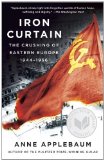Summary | Excerpt | Reviews | Beyond the Book | Readalikes | Genres & Themes | Author Bio

Critics' Opinion:
Readers' Opinion:
First Published:
Oct 2012, 608 pages
Paperback:
Aug 2013, 640 pages
 Book Reviewed by:
Book Reviewed by:
Kim Kovacs
Buy This Book
This last point is controversial. For in the standard historiography, the region's postwar history is usually divided into phases. 21 First there was genuine democracy, in 1944 – 5 ; then bogus democracy, as Hugh Seton-Watson once wrote; and then, in 1947 – 8 , an abrupt policy shift and a full-fledged takeover: political terror was stepped up, the media muzzled, elections manipulated. All pretence of national autonomy was abandoned. Some historians and political scientists have since blamed this change in political atmosphere on the onset of the Cold War, with which it coincided. Sometimes, this onset of Stalinism in Eastern Europe is even blamed on Western Cold Warriors, whose aggressive rhetoric allegedly 'forced' the Soviet leader to tighten his grip on the region. In 1959 , this general 'revisionist' argument was given its classic form by William Appleman Williams, who argued that the Cold War had been caused not by communist expansion but by the American drive for open international markets. More recently, a prominent German scholar has argued that the division of Germany was caused not by the Soviet pursuit of totalitarian policies in Eastern Germany after 1945, but by the Western powers' failure to take advantage of Stalin's peaceful overtures.
Any close examination of what was happening on the ground across the region between 1944 and 1947 reveals the deep flaws of these arguments – and, thanks to the availability of Soviet as well as Eastern European archives, a close examination is now possible.
New sources have helped historians understand that this early 'liberal' period was, in reality, not quite so liberal as it sometimes appeared in retrospect. True, not every element of the Soviet political system was imported into the region as soon as the Red Army crossed the borders, and indeed there is no evidence that Stalin expected to create a communist 'bloc' very quickly. In 1944 , his Foreign Minister, Ivan Maiskii, wrote a note predicting that the nations of Europe would eventually all become communist states, but only after three or perhaps four decades. (He also foresaw that in the Europe of the future there should be only one land power, the USSR , and one sea power, Great Britain.) In the meantime, Maiskii thought the Soviet Union should not try to foment 'proletarian revolutions' in Eastern Europe and should try to maintain good relations with the Western democracies.
This long-term view was certainly in accordance with Marxist- Leninist ideology as Stalin understood it. Capitalists, he believed, would not be able to cooperate with one another for ever. Sooner or later their greedy imperialism would lead them into conflict, and the Soviet Union would benefit. 'The contradictions between England and America are still to be felt,' he told colleagues a few months after the war's end. 'The social conflicts in America are increasingly unfolding. The Labourites in England have promised the English workers so much concerning socialism that it is hard for them now to step back. They will soon have conflicts not only with their bourgeoisie, but also with the American imperialists.'
If the USSR was not in a rush, neither were the Eastern European communist leaders, few of whom expected to take power immediately. In the 1930 s, many had participated in 'national front' coalitions together with centrist and socialist parties – or had watched as national front coalitions were successful in a number of countries, most notably Spain and France. The historian Tony Judt has even described Spain as 'a dry run for the seizure of power in Eastern Europe after 1945 '. These original national front coalitions had been created to oppose Hitler. In the war's aftermath, many prepared to re-create them in order to oppose Western capitalism. Stalin took a long-term view: the protelarian revolution would take place in due course, but before that could happen, the region first had to have a bourgeois revolution. According to the schematic Soviet interpretation of history, the necessary bourgeois revolution had not yet taken place.
Excerpted from Iron Curtain by Anne Applebaum. Copyright © 2012 by Anne Applebaum. Excerpted by permission of Doubleday. All rights reserved. No part of this excerpt may be reproduced or reprinted without permission in writing from the publisher.





The House on Biscayne Bay
by Chanel Cleeton
As death stalks a gothic mansion in Miami, the lives of two women intertwine as the past and present collide.

The Flower Sisters
by Michelle Collins Anderson
From the new Fannie Flagg of the Ozarks, a richly-woven story of family, forgiveness, and reinvention.

The Funeral Cryer by Wenyan Lu
Debut novelist Wenyan Lu brings us this witty yet profound story about one woman's midlife reawakening in contemporary rural China.
Your guide toexceptional books
BookBrowse seeks out and recommends the best in contemporary fiction and nonfiction—books that not only engage and entertain but also deepen our understanding of ourselves and the world around us.